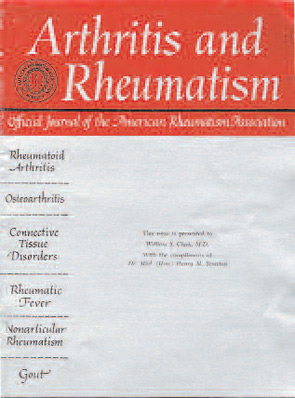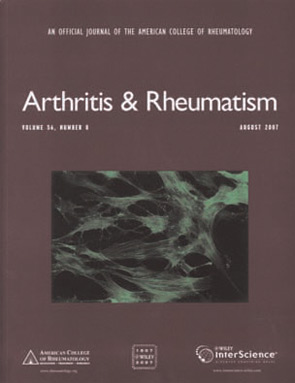Next February marks a major milestone for rheumatology: The ACR’s journal Arthritis & Rheumatism (A&R) turns 50. The first issue of A&R rolled out in February 1958, before rheumatology was even a recognized subspecialty and when new information and research surrounding the field were developing at a breakneck pace.
A&R kept up with that pace, and has established itself as an essential publication for rheumatologists in the United States and abroad. “This is the highest-ranked journal in rheumatology in the world,” says William P. Arend, MD, professor of medicine in the rheumatology division at the University of Colorado Health Sciences Center in Aurora, who served as editor from 1995 to 2000. “It’s the foremost rheumatology research journal.”
Editorial History
There have been 10 editors in the history of the journal. William S. Clark, MD, the first editor, served for eight years; each subsequent editor has served a five-year term. Nine editors are still alive and active in the ACR. “We have a remarkably healthy and long-lived set of editors,” says Michael D. Lockshin, MD, current editor of A&R and a rheumatologist with the Hospital for Special Surgery at Cornell University in New York City, as well as a professor of medicine and obstetrics-gynecology at Weill-Cornell Medical College.
All nine living editors are participating in next year’s anniversary celebration in some way.
Anniversary Plans
Several plans are in the works to mark the occasion. “In a sense, it’s a celebration of the past,” says Dr. Lockshin, “but much more importantly, it’s a look at the future – at the future of our mission and how we serve the community.”
The very first look at the past and future of A&R will be a special educational session at the ACR/ARHP Annual Scientific Meeting in Boston this November. The session will explore the journal’s history and how it might look in the future.
“We’re going to have a few of the former editors and current contributors discussing the science issues that have evolved over the years,” explains Dr. Lockshin. He points out that a review of A&R articles published during the past half century clearly shows the changes in science within rheumatology.
A&R will get a new look for the anniversary as well. The cover is being redesigned, and additional changes to inside pages will come thereafter. At least one new feature will be added: “In the journal, by the table of contents, we’re adding an ‘In this Issue’ section that will highlight articles,” says Dr. Lockshin.
Watch for a Special Supplement
A separate 50th anniversary supplement issue of the journal will be published in February 2008. The supplement will include several sections, including past articles and commentary by each living former editor; an article by David A. Fox, MD, the 2007–2008 ACR president, on the role of A&R within the organization; comments from rheumatologists around the world on how A&R fits into their lives; and an article that looks to the future.
“I’ve asked a fellow in training and a freelance writer to contribute articles on what they think publishing is going to be like 50 years from now,” says Dr. Lockshin. “From 1958 to 1998, we had a fairly uniform process for this. What we do now is going to change radically in the next 10 years. We’re targeted to scientists in rheumatology, but soon we’ll be read by anyone who wants to ‘blog’ us, and I don’t know what that will do to change our mission.”


It’s a celebration of the past, but much more importantly, it’s a look … at the future of our mission and how we serve the community.
As for the reprinted articles, Dr. Lockshin explains, “all of the living editors have chosen what they consider to be a classic article for their time. They’ve written a companion article to each that discusses the changes in science since the original article was published. The changes are clearly visible when you look back.” These commentaries tie in closely with the material presented at the educational session on A&R at the scientific meeting.
Scientific Evolution
Journal readers can trace the often-rapid development of new science through articles published in A&R.
“Early on, it emphasized more clinical research, and gradually added more science,” says Dr. Arend. “The journal was quick to publish new sciences such as molecular biology, and it’s become more scientific over the years.”
David S. Pisetsky, MD, PhD, professor of medicine and immunology at Duke University Medical Center in Durham, N.C., physician editor of The Rheumatologist, and the most recent A&R past editor, says, “The journal reflects the enormous increase in the sophistication of the science. Rheumatology is a large, vibrant field, and the journal has played an important part in that.”
A Look Back
The Rheumatologist asked several past editors to comment on the journal both under their guidance and today.
“As a ‘time capsule’ for comparison to the year 2008 there are some dramatic contrasts,” says Charles L. Christian, MD, a rheumatologist at the University of Florida, Jacksonville, of the journal under his editorship between 1971 and 1975. “There was the growth of rheumatology as a clinical discipline … as well as the volume of scientific work pertinent to the rheumatic diseases and heightened competition for its acceptance for publication in A&R.”
Dr. Christian also cites “the scientific excellence of papers accepted for publication” in the early 70s, as well as “the power of collaboration in research, multi-institutional and multi-authorship, [as well as] the global character of biomedical research.”
Dr. Arend says of his tenure from 1995 to 2000, “The major milestone was actually the continuation of a trend: the increasing percentage of manuscripts submitted from outside the U.S.”
Dr. Pisetsky, who immediately followed Dr. Arend, serving as editor from 2000 to 2005, agrees. “The world has gotten bigger, and there’s outstanding science being done all over the world,” he points out. “Just as science advanced here, it advanced in Europe and in Asia.”
As the research and science presented in the pages of the journal have evolved, change was also happening behind the scenes. An electronic submission and review process was implemented, increasing the efficiency and speed of the journal’s production. This new process may have helped boost the number of submissions, although progress in the field – especially the increasing prevalence of biological therapies – also had a hand in the journal’s growth.
Who knows what the future holds for A&R? Perhaps the prediction article in the supplement will provide some answers. In the meantime, watch for the journal’s new look and for the special anniversary supplement in February.
Jane Jerrard is a frequent contributor to The Rheumatologist.



